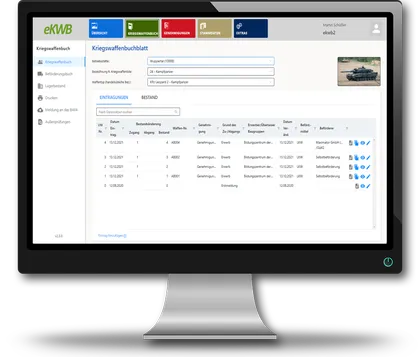What is the War Weapons Book for?
The War Weapons Register is a central instrument for compliance with the German War Weapons Control Act (KrWaffKontrG). It serves to seamlessly document all changes in the inventory of war weapons and ensures that every movement – be it acquisition, transfer, manufacture, repair or transportation – is traceable.
This documentation obligation is intended to enable effective control by the competent authorities and contributes to national and international security. The War Weapons Register is therefore not only of administrative significance, but also of security policy significance.
What information must be recorded?
According to the KrWaffKontrG, the war weapons register must be kept in such a way that it is clear at all times which war weapons are in the possession of the company and how they got there. The entries must be complete, correct and consecutive.
The following information must be documented:
Type and designation of the weapon
Every weapon of war must be clearly identifiable by its technical designation.Weapon number or other unique identification
These features are used for the precise traceability of individual weapons or components.Date of inventory change
Every change in the inventory must be documented with the exact date.Name and address of the transferor or transferee
This information ensures that external business transactions can also be traced.Authorization number and issuing authority
No transaction may be carried out without the corresponding authorization. Documentation of this data is mandatory.Intended use or whereabouts of the firearm
In certain cases, the purpose for which the firearm is being used or where it is being transferred must be stated.Information on transportation
The transportation of war weapons must also be precisely documented.
All this information must be entered promptly after the respective inventory change. Subsequent additions or corrections must be marked separately.
Form and structure of accounting
The war weapons register can be kept either in paper form or in an electronic version. Both forms are subject to the same content requirements, but differ considerably in terms of effort and efficiency.
Traditional paper-based management is time-consuming, error-prone and requires a high degree of manual control. This method quickly reaches its limits, especially with large inventories or frequent inventory changes.
On the other hand, electronic storage – the so-called electronic War Weapons Book (eKWB) – offers numerous advantages:
Automated checks ensure that the entries are formally correct.
Search and filter functions facilitate daily work and preparation for external audits.
Digital interfaces make it easy to transmit legally required reports to the BAFA.
Access logs provide audit-proof documentation of who made which changes and when.
Retention obligation and audits
Companies are obliged to keep the war weapons log for a period of ten years. It must be ensured that the data is legible, complete and unchanged at all times during this period.
The competent authorities, in particular the BAFA, are entitled to inspect and check the war weapons logbook as part of external audits. This involves checking whether the bookkeeping is complete and compliant. Properly kept documentation can not only speed up the audit, but also create legal certainty.








